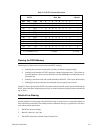
5–9Vertical Format Units
Table 5–5. DVFU Channel Instruction
ASCII Channel
Hex
00
01
02
03
04
05
06
07
08
09
0A
0B
PI 7 6 5 4 3 2 1
1
1
1
1
1
1
1
1
1
1
1
1
X
X
X
X
X
X
X
X
X
X
X
X
X
X
X
X
X
X
X
X
X
X
X
X
0
0
0
0
0
0
0
0
0
0
0
0
0
0
0
0
0
0
0
0
1
1
1
1
0
0
0
0
1
1
1
1
0
0
0
0
0
0
1
1
0
0
1
1
0
0
1
1
0
1
0
1
0
1
0
1
0
1
0
1
1
2
3
4
5
6
7
8
9
10
11
12
Dec
1
0
2
3
4
5
6
7
8
9
10
11
X = Undefined, 0 or 1
1 = High
0 = Low
8
X
X
X
X
X
X
X
X
X
X
X
X
Data Bits
NUL
SOH
STX
ETX
EOT
ENQ
ACK
BEL
BS
HT
LF
VT
Code
Clearing the DVFU Memory
Following
one of these actions resets (clears) the DVFU memory
.
•
Sending only the start load and end load codes (no channel assignment data).
• Sending
an odd number of DVFU characters (channel assignment data). (The printer de
-
tects
the characters after it
receives the end load code.) Remember
, two data bytes are re
-
quired per line.
• Sending
a second start
load code, which reinitializes the DVFU. (This restarts the host data)
• Sending the first byte (after the start load) that does not specify top–of–form.
The
DVFU data is ignored if the DVFU has not been selected from the control panel. Deselecting the
DVFU
returns the forms length to
the previously set value and the current print position becomes the
top–of–form.
Relative Line Slewing
Another
method of moving paper using the PI line results in vertical slews of a specified number of
lines
within the form relative to the current print line (rather than slewing to a specific line). For this
to
occur, three criteria must be met:
1. The PI line must be set high;
2. Data bit 5 must be 1 (set); and
3.
The DVFU must be the selected V
ertical Format Unit.


















